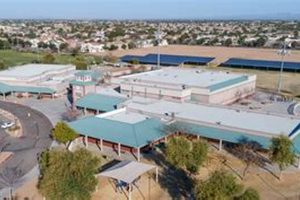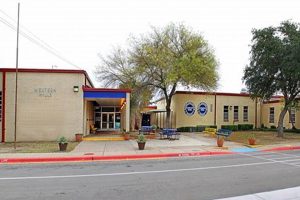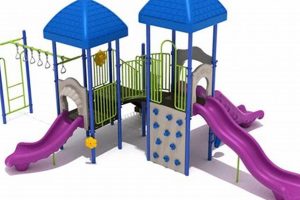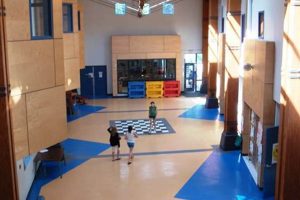Educational programs based on the Montessori Method for children aged approximately six to twelve represent a distinctive approach to learning. These environments typically feature mixed-age classrooms, self-directed activities, and specialized learning materials. Students are encouraged to explore their interests and learn at their own pace within a structured framework, fostering independence and a lifelong love of learning. For example, a student might choose to work with geometric solids one day and delve into historical research the next, guided by their curiosity and developmental needs.
This pedagogical approach emphasizes hands-on, experiential learning and the development of practical life skills. Children cultivate critical thinking, problem-solving abilities, and a strong sense of community responsibility through collaborative projects and individual exploration. Originating with Dr. Maria Montessori’s work with children in the early 20th century, this educational philosophy has demonstrated a lasting impact on educational practices worldwide, promoting individualized instruction and a focus on the whole child’s development social, emotional, intellectual, and physical.
The following sections will delve deeper into specific aspects of these programs, exploring curriculum design, teacher training, and the long-term benefits for students. Further discussion will address the practical considerations for parents, including program selection and the role of parental involvement in supporting the child’s educational journey.
Tips for Selecting a Program
Choosing the right educational environment is a crucial decision for families. The following tips offer guidance for navigating the selection process and ensuring a positive learning experience.
Tip 1: Observe a Classroom: Visiting a potential learning environment provides invaluable insight. Observe student engagement, teacher interaction, and the overall atmosphere.
Tip 2: Inquire About Teacher Training: Specialized training is essential for educators in this method. Verify that teachers hold appropriate credentials and engage in ongoing professional development.
Tip 3: Explore the Curriculum: A comprehensive curriculum should encompass academic subjects, practical life skills, and opportunities for creative expression. Examine learning materials and the scope of offered activities.
Tip 4: Consider the Learning Environment: A well-prepared environment is characterized by order, beauty, and accessibility. Materials should be thoughtfully arranged and readily available to students.
Tip 5: Assess the School’s Philosophy: Ensure the school’s mission and values align with familial educational goals and priorities.
Tip 6: Evaluate Community Engagement: A strong sense of community fosters a supportive learning environment. Inquire about parent involvement opportunities and school events.
Tip 7: Consider Practical Logistics: Factors such as location, schedule, and tuition costs should align with family needs and resources.
Careful consideration of these factors will empower families to make informed decisions, selecting an educational setting that nurtures each child’s unique potential and fosters a lifelong love of learning.
By understanding the nuances of these educational settings and applying the provided tips, families can embark on an enriching educational journey, fostering their child’s individual growth and academic success. The concluding section will offer final thoughts and resources for continued exploration.
1. Child-Centered Learning
Child-centered learning forms the cornerstone of the Montessori elementary educational approach. This pedagogical philosophy prioritizes the individual needs and interests of each student, recognizing that learning is most effective when driven by intrinsic motivation and curiosity. Rather than a standardized, teacher-directed curriculum, classrooms offer a prepared environment rich in materials that encourage exploration and discovery. Students are empowered to choose activities aligned with their developmental stage and interests, fostering a sense of ownership over their learning journey. This approach cultivates self-reliance, critical thinking, and a lifelong love of learning. For instance, a student fascinated by botany might choose to work with plant specimens, conduct independent research, and create a presentation to share their findings with classmates. This self-directed exploration, guided by a trained educator, allows the student to delve deeply into a subject of personal interest, fostering a sense of accomplishment and intellectual curiosity.
The emphasis on child-centered learning fosters a dynamic and responsive learning environment. Educators act as facilitators, guiding students’ exploration and providing support when needed. Observation plays a key role, enabling educators to understand individual learning styles and tailor instruction accordingly. This individualized approach recognizes that each child learns at their own pace and in their own way. Practical applications of this philosophy are evident in the mixed-age classrooms, which create opportunities for peer learning and mentorship. Younger students learn from older peers, while older students reinforce their understanding by teaching concepts to younger classmates. This collaborative environment cultivates a sense of community and shared responsibility for learning.
In summary, child-centered learning is not merely a component of Montessori elementary education; it is its defining principle. By placing the child at the heart of the learning process, this approach nurtures intrinsic motivation, fosters independence, and cultivates a lifelong love of learning. While implementing this approach requires specialized training and a thoughtfully prepared environment, the benefits of empowering students to direct their own learning journey are profound and long-lasting. This focus on individual growth and development lays a strong foundation for future academic success and lifelong learning.
2. Prepared Environment
The prepared environment represents a cornerstone of Montessori elementary education. It is a carefully designed space that fosters independence, self-directed learning, and a sense of order. This environment is not merely a backdrop for learning; it is an integral component of the Montessori pedagogy, directly influencing the child’s engagement and developmental progress. Cause and effect are deeply intertwined within this setting. The availability of specifically designed materials, arranged logically and aesthetically on accessible shelves, encourages children to select activities that pique their interest. This self-selection, in turn, fosters concentration, a sense of personal responsibility, and deeper learning. For example, a child drawn to geography might choose a puzzle map of the world, leading to independent exploration of continents, countries, and cultures.
The prepared environment’s importance stems from its ability to facilitate auto-education, a central tenet of Montessori philosophy. Children are naturally driven to learn and explore. The prepared environment provides the tools and structure for this self-discovery to unfold. Practical life materials, such as pouring, scooping, and buttoning frames, help children develop fine motor skills and coordination. Sensorial materials, like color tablets and textured fabrics, refine sensory perception and discrimination. These concrete experiences lay a strong foundation for later abstract learning. Furthermore, the emphasis on order and beauty within the environment cultivates a sense of respect for materials and a peaceful atmosphere conducive to concentration. The intentional design of the space extends to the arrangement of furniture, creating distinct areas for different activities, promoting focus and minimizing distractions.
Understanding the significance of the prepared environment provides key insights into the efficacy of Montessori elementary education. It is not simply a collection of materials; it is a dynamic ecosystem designed to facilitate self-directed learning and holistic development. While creating and maintaining such an environment requires specialized training and resources, the benefits for students are substantial. The prepared environment empowers children to become active agents in their own learning, fostering independence, critical thinking, and a lifelong love of learning. This understanding also highlights the importance of teacher training and ongoing observation, as educators play a crucial role in guiding children within this carefully crafted space, ensuring its effectiveness in supporting individual growth and development.
3. Self-Directed Activity
Self-directed activity forms a cornerstone of Montessori elementary education, deeply intertwined with the method’s core principles. Within these educational settings, children are empowered to choose their activities, fostering independence, intrinsic motivation, and a profound sense of ownership over their learning journey. This approach stands in contrast to traditional teacher-directed models, where a prescribed curriculum dictates learning pathways. Instead, the Montessori environment offers a carefully curated selection of materials designed to engage a child’s natural curiosity and developmental needs. The freedom to choose allows children to explore subjects that resonate with them, leading to deeper engagement and more meaningful learning experiences. For instance, a child captivated by geometry might choose to work extensively with geometric solids, exploring shapes, relationships, and spatial reasoning. This self-directed exploration, guided by a trained educator, leads to a more profound understanding than might be achieved through passive absorption of information.
The practical significance of this approach is evident in several key areas. Self-direction cultivates concentration, a crucial skill for academic success and lifelong learning. When children choose activities that genuinely interest them, they are more likely to focus intently and persevere through challenges. This fosters a sense of self-efficacy and resilience, empowering children to take ownership of their learning and tackle complex tasks. Moreover, self-directed activity promotes self-regulation and time management skills. Children learn to prioritize tasks, manage their time effectively, and transition smoothly between activities. These skills, cultivated through consistent practice in a supportive environment, are essential for success in all aspects of life. Furthermore, self-direction nurtures a love of learning. By associating learning with choice and exploration, children develop a positive attitude towards education, viewing it as a source of joy and discovery rather than an obligation.
In summary, self-directed activity is not merely a component of Montessori elementary education; it is a fundamental principle that shapes the entire learning experience. This approach cultivates essential skills such as concentration, self-regulation, and a love of learning, laying a strong foundation for future academic success and lifelong personal growth. While successful implementation requires a carefully prepared environment and skilled educators, the benefits of empowering children to direct their own learning journey are substantial and enduring. The cultivation of self-directed learners equipped with the skills and motivation to navigate a complex and ever-changing world represents a significant contribution of this educational approach.
4. Hands-on Materials
Hands-on materials represent a defining characteristic of Montessori elementary education, intrinsically linked to the method’s emphasis on experiential learning. These materials are not mere toys or supplementary resources; they serve as carefully designed tools that engage students in active learning, fostering deep understanding and the development of essential skills. The connection between these materials and the Montessori approach lies in the understanding that children learn best through direct interaction with the world around them. Concrete experiences with manipulative materials lay a strong foundation for abstract thinking, allowing students to internalize concepts through sensory exploration and manipulation. Cause and effect are directly observable. For example, working with the Golden Bead material for mathematics allows a child to physically manipulate units, tens, hundreds, and thousands, providing a concrete representation of abstract numerical concepts. This tactile experience leads to a more profound understanding of place value than rote memorization or abstract explanations.
The importance of hands-on materials extends beyond the acquisition of specific academic skills. These materials foster critical thinking and problem-solving abilities. Many Montessori materials present a problem or challenge that the child must solve through manipulation and experimentation. For example, the Trinomial Cube requires the child to assemble a complex three-dimensional puzzle, developing spatial reasoning and problem-solving strategies. Further practical applications are evident in the development of fine motor skills, hand-eye coordination, and concentration. Activities such as pouring, spooning, and working with small objects refine dexterity and precision, preparing children for more complex tasks. Furthermore, the self-correcting nature of many Montessori materials fosters independence and self-assessment. Children can identify and correct their own errors without direct teacher intervention, building confidence and self-reliance.
In summary, hands-on materials are not merely supplemental resources in Montessori elementary education; they are integral tools that drive the learning process. This approach recognizes the profound impact of concrete experiences on cognitive development, fostering deep understanding, critical thinking, and essential life skills. While effective implementation requires specialized training and carefully designed materials, the benefits of engaging students through tactile and kinesthetic learning experiences are significant and enduring. This emphasis on hands-on learning represents a key distinction of the Montessori method and contributes substantially to its enduring relevance in a rapidly changing educational landscape.
5. Mixed-age classrooms
Mixed-age classrooms represent a distinctive feature of Montessori elementary environments, serving not merely as a logistical arrangement but as a deliberate pedagogical choice deeply intertwined with the Montessori philosophy. This structuring of the learning environment fosters a unique social dynamic and creates opportunities for peer learning, collaboration, and the development of essential social skills. A cause-and-effect relationship exists between the mixed-age grouping and several key aspects of Montessori education. The older students, having previously explored concepts and mastered skills, often serve as mentors to younger classmates, reinforcing their own understanding through the act of teaching. Conversely, younger students benefit from observing and interacting with older peers, gaining exposure to more advanced concepts and developing a sense of aspiration. This natural mentorship dynamic fosters a sense of community and shared responsibility for learning. For example, a younger student struggling with a particular mathematical concept might observe an older student working with the same material, gaining insights and encouragement through observation and interaction.
The practical significance of mixed-age classrooms extends beyond academic learning. These environments cultivate empathy, patience, and leadership skills. Older students develop responsibility and leadership qualities by assisting younger classmates, while younger students learn to respect and learn from their older peers. This social dynamic creates a more naturalistic learning environment, mirroring the interactions children experience in families and communities. Furthermore, mixed-age classrooms contribute to a sense of continuity and stability within the learning environment. As children progress through the program, they remain within the same classroom for several years, building strong relationships with their peers and teachers. This fosters a sense of belonging and security, allowing children to focus on their individual learning journeys. Moreover, the mixed-age grouping allows for individualized pacing and differentiated instruction. Children can progress through the curriculum at their own pace, without the pressure of rigid grade-level expectations. This flexibility supports the development of intrinsic motivation and a lifelong love of learning.
In summary, mixed-age classrooms are not merely a structural element of Montessori elementary education; they are integral to the method’s pedagogical approach. This intentional grouping fosters a dynamic learning environment characterized by peer learning, collaboration, and the development of essential social skills. While successful implementation requires skilled educators who can manage the diverse needs of a mixed-age group, the benefits for students are significant and far-reaching. This aspect of Montessori education underscores the method’s commitment to holistic development, recognizing the interconnectedness of academic, social, and emotional growth in the educational journey. The creation of a supportive and collaborative learning community within mixed-age classrooms represents a significant contribution of the Montessori approach to elementary education.
6. Trained Montessori Guides
Trained Montessori guides play a pivotal role within Montessori elementary environments, serving not merely as instructors but as facilitators of learning, carefully guiding students’ exploration and development within the prepared environment. Their specialized training is essential to the effective implementation of the Montessori method, impacting every facet of the educational experience. A cause-and-effect relationship exists between the presence of trained guides and the successful realization of Montessori principles. The guide’s understanding of child development, coupled with their expertise in utilizing Montessori materials, creates a dynamic learning environment where students can thrive. For example, a guide might observe a student struggling with a specific mathematical concept and then offer a tailored presentation using concrete materials, fostering deeper understanding. Without a trained guide’s intervention, the student might remain stuck, hindering their progress and potentially diminishing their enthusiasm for learning. The guide’s role also extends to observing and documenting each child’s progress, tailoring the learning experience to individual needs and interests.
The practical significance of having trained Montessori guides is multifaceted. Their expertise is crucial in maintaining the prepared environment, ensuring that materials are organized, accessible, and presented in a manner that promotes self-directed learning. They facilitate the mixed-age classroom dynamics, guiding older students in mentorship roles and supporting younger students in their explorations. Furthermore, trained guides foster a sense of community within the classroom, creating a supportive and respectful environment where students feel empowered to take risks and learn from their mistakes. A real-world example might involve a guide facilitating a collaborative project where students of different ages research and present information on a chosen topic, fostering teamwork, communication skills, and a deeper understanding of the subject matter. This level of facilitation requires specialized training, as it involves guiding students with varying levels of understanding and experience towards a common goal.
In summary, trained Montessori guides represent an indispensable component of successful Montessori elementary programs. Their specialized training and understanding of child development are crucial for creating a learning environment that fosters independence, critical thinking, and a lifelong love of learning. While the investment in specialized training represents a significant commitment, the benefits for students are profound and long-lasting. The guide’s ability to nurture each child’s unique potential within a carefully prepared environment distinguishes Montessori education and contributes significantly to its enduring impact on the educational landscape. The efficacy of the Montessori method at the elementary level rests heavily upon the expertise and dedication of these trained professionals, highlighting the essential connection between skilled guidance and the successful implementation of this child-centered approach.
7. Holistic Development
Holistic development represents a central tenet of Montessori elementary education, extending beyond academic achievement to encompass social, emotional, physical, and spiritual growth. This integrated approach recognizes the interconnectedness of these domains, acknowledging that a child’s well-being and capacity for learning are influenced by factors extending beyond traditional academic metrics. A cause-and-effect relationship exists between the Montessori environment and the fostering of holistic development. The prepared environment, with its emphasis on self-directed activity and hands-on materials, naturally supports the development of independence, concentration, and problem-solving skills. Mixed-age classrooms provide opportunities for social interaction, collaboration, and the development of empathy and leadership skills. For example, a child engaged in building a complex structure with wooden blocks not only develops spatial reasoning and fine motor skills but also cultivates perseverance, problem-solving strategies, and a sense of accomplishment. These experiences contribute to the child’s overall development, fostering self-confidence and a positive self-image.
The practical significance of this approach lies in its capacity to nurture well-rounded individuals equipped to navigate the complexities of life. Montessori education recognizes that academic success is but one facet of a fulfilling life. The emphasis on practical life skills, such as preparing food, caring for the environment, and interacting respectfully with others, equips children with essential life skills. Furthermore, the focus on self-expression through art, music, and movement nurtures creativity and emotional intelligence. A real-world example might involve students collaborating on a garden project, learning about plant life cycles, teamwork, and responsibility while contributing to the school community. This project exemplifies the holistic nature of Montessori education, integrating academic learning with practical skills, social interaction, and environmental awareness.
In summary, holistic development is not merely a desirable outcome of Montessori elementary education; it is a core principle that shapes the curriculum, the learning environment, and the role of the educator. This commitment to nurturing the whole child contributes significantly to the enduring relevance of Montessori education in a world increasingly focused on standardized testing and narrow definitions of success. While implementing this approach requires specialized training, thoughtfully designed environments, and ongoing observation, the benefits of fostering well-rounded, adaptable individuals equipped to thrive in a complex and ever-changing world are substantial and enduring. Addressing the challenges of fostering holistic development within the context of diverse learning needs and societal pressures remains an ongoing conversation within Montessori communities, highlighting the continued importance of this principle in shaping educational practices.
Frequently Asked Questions
This section addresses common inquiries regarding elementary programs based on the Montessori Method, providing concise and informative responses.
Question 1: How does the Montessori approach differ from traditional elementary education?
Montessori education emphasizes self-directed learning within a prepared environment, utilizing specialized materials and mixed-age classrooms. Traditional models typically feature teacher-directed instruction, uniform-age groupings, and standardized curricula.
Question 2: What is the role of the teacher in a Montessori classroom?
Montessori educators, often called guides, facilitate learning by observing students, preparing the environment, and offering individualized guidance. They do not deliver traditional lectures but rather empower students to explore and discover concepts independently.
Question 3: Are Montessori programs suitable for all children?
While the Montessori approach can benefit a wide range of learners, it’s essential to consider individual learning styles and needs. Observing a classroom and discussing a child’s specific needs with Montessori educators can help determine suitability.
Question 4: How is academic progress assessed in a Montessori setting?
Assessment in Montessori settings involves ongoing observation of student work, engagement with materials, and interactions with peers. Formal assessments may also be utilized, depending on the specific program and local regulations.
Question 5: Do Montessori programs adequately prepare students for standardized tests?
Studies indicate that students in Montessori programs often perform comparably or better on standardized tests than their peers in traditional programs. The emphasis on critical thinking, problem-solving, and self-directed learning equips them well for these assessments.
Question 6: What is the long-term impact of a Montessori education?
Research suggests that Montessori education can foster a lifelong love of learning, strong academic skills, and essential social-emotional competencies, contributing to success in higher education, careers, and personal fulfillment.
These responses provide a starting point for understanding the key distinctions of Montessori elementary education. Further research and consultation with Montessori educators are encouraged for a comprehensive understanding.
The following section explores resources and further avenues for exploring this unique educational approach.
Conclusion
Exploration of elementary-level Montessori education reveals a distinctive approach to child development. Key elements include the prepared environment, self-directed activity, specialized learning materials, and the role of trained guides. These components foster holistic development, nurturing not only academic progress but also social-emotional growth, critical thinking, and a lifelong love of learning. The emphasis on individualized learning journeys within a structured, supportive environment distinguishes this educational approach.
The potential of Montessori education to cultivate well-rounded individuals equipped to navigate the complexities of a rapidly changing world merits continued exploration and consideration. Further research into the long-term impacts of these programs and the adaptability of the Montessori method to diverse learning needs promises valuable insights for the future of education. The focus on fostering intrinsic motivation and empowering children as active participants in their own learning journey positions these educational settings as relevant and dynamic contributors to the evolving landscape of education.







